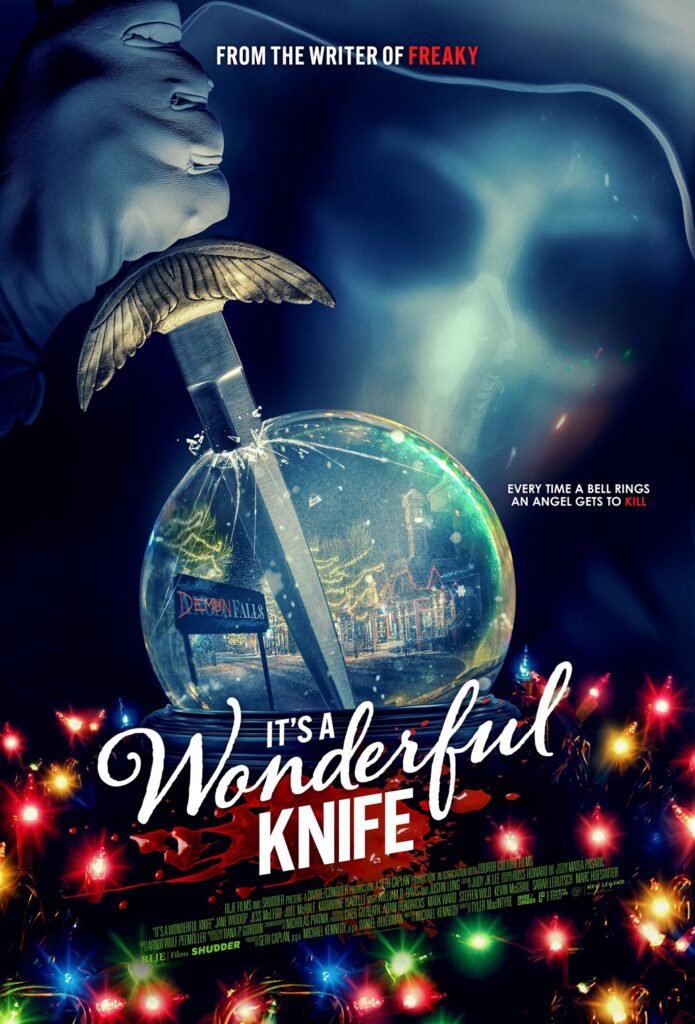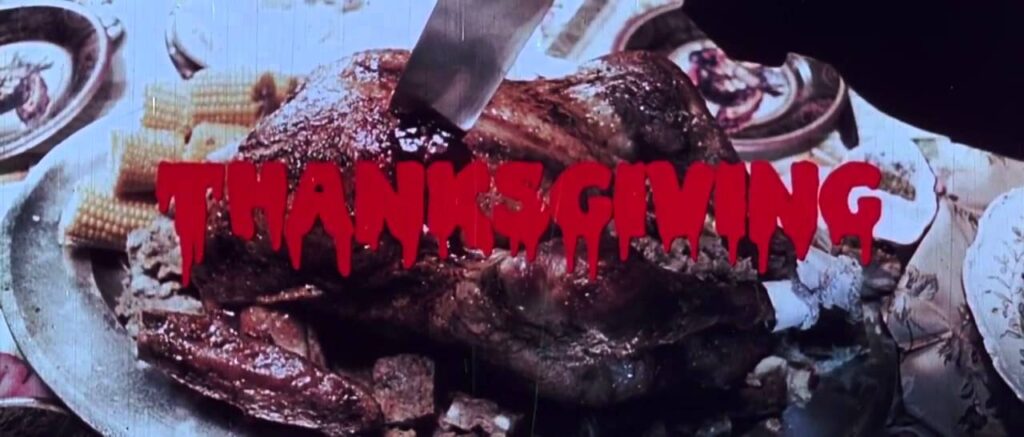Sometimes I like to think of genre filmmaking as a long, perpetual relay race where filmmakers pass the baton across the ages, passing it down through the decades as various hands shape, reshape, subvert, or dutifully carry on. Few of these batons have been handed off more frequently than the blood-soaked staff of slasher movies, a genre that’s proven to be paradoxically formulaic and fresh through the years. Say what you want about this disreputable corner of the horror genre, but it’s been every bit as resilient as its myriad of unstoppable psychopaths, twisting, turning, and contorting to the point where it’s become a snake eating its own tail following its postmodern deconstruction in the 90s and its subsequent reconstruction during the past few years.
It’s fair to ask where the genre can even go at this point, but it’s equally fair to admit that it doesn’t matter: what’s important is that it’s still here, still thriving, and not going anywhere except hurtling forward, onward and upward as filmmakers new and old either sprint off out of the lane with the baton or simply fidget with it. During the past two weeks alone, we’ve even seen an even more specific baton—I like to imagine it’s just a really fancy candy cane—change hands within the realm of holiday slashers with IT’S A WONDERFUL KNIFE and THANKSGIVING, a double bill that reminds us that this genre is still full of juice (or maybe Karo syrup is more apt) whether it’s being squeezed out by inventive newcomers or by the steady-handed old guard. The two sprint off in opposite directions, yet draw audiences to the same conclusion: it’s never been a better time to be a slasher fan.
IT’S A WONDERFUL KNIFE
Frank Capra’s IT’S A WONDERFUL LIFE is among the purest expressions of mankind’s capacity for utter goodness: it embodies the selfless spirit of the season in a way that’s sublime. Forget tugging at your heartstrings: those final fifteen minutes or so completely obliterate my insides. I’ve never been able to make it through George Bailey’s triumphant return to reality without weeping, and I hope I never do. It’s the ultimate form of catharsis, an annual, ritualistic purging of emotions as another year passes into the ether of time and memory to recenter me and my priorities. And while the film briefly digresses off into the aesthetics of gothic horror and dabbles in some existential dread, nobody in their right mind could really imagine its premise being twisted into a slasher movie.
Thankfully, screenwriter Michael Kennedy wasn’t in his right mind when hatching IT’S A WONDERFUL KNIFE, his raucous riff on Capra’s holiday staple. It’s not the first to hijack the film’s climactic alternate reality conceit, but it’s arguably the gutsiest evocation of it—in more ways than one, of course. No stranger to high-concept slasher mayhem as the mind behind 2020’s FREAKY, Kennedy dares to blend Capra’s sweet sentimentality with gnarly, riotous bloodletting, an oil-and-water combination if there ever was one. And yet he and director Tyler MacIntyre (TRAGEDY GIRLS, V/H/S/99) pull off an alchemic blend with aplomb: IT’S A WONDERFUL LIFE is a sweet, rousing triumph that also happens to feature someone being electrocuted to death by jumper cables.

Winnie Carruthers’ (Jane Widdop) hometown of Angel Falls is an idyllic slice of Americana, especially at Christmas time, when the town is blanketed by snow and bathed in a holiday glow. Her family and friends are a particularly cozy bunch who observe the same holiday traditions each year. Unfortunately, that often includes her father (Joel McHale) being pulled away at the behest of Henry Waters (Justin Long), the town’s mayor and most notorious entrepreneur. His exploits on this particular Christmas Eve reveal a sinister undercurrent rumbling beneath Angel Falls as he attempts to force Roger Evans (William B. Davis) from his family home so he can build a new shopping complex, something the elderly man has no intention of doing. Rejected but undeterred, Waters vows to take the home by hook and crook, and, soon enough, a masked psycho descends on the holiday festivities, butchering Winnie’s best friend (Hanna Huggins) during a killing spree.
Fortunately, Winnie curbs the massacre by taking out the killer just before her brother (Aiden Howard) becomes a victim. And wouldn’t you know it: it turns out that Mayor Waters—the lone Scrooge haunting this holiday haven—is beneath the mask. When a year passes and Winnie realizes she’s the only one who hasn’t been able to move on, she decides it would have been best if she hadn’t been born at all, and she’s whisked away to a dystopian reality where the killer’s reign of terror continues unabated. Now trapped in his alternate reality, her only hope of escape is convincing outcast classmate Bernie Simon (Jess McLeod) to help her unmask and kill Angel Falls’ fiendish slasher all over again.

What’s immediately striking about IT’S A WONDERFUL KNIFE is how goddamn sincere it is. Unlike some other horror mash-ups in recent memory, this blending isn’t an act of edgelord provocation. Kennedy and MacIntyre aren’t trying to taint or warp anyone’s warm, fuzzy memories of watching Capra’s holiday staple, nor are they even exploiting the obvious ironic disconnect between the two genres. It’s not a slasher spoof, nor does it make a total farce of the iconic conceit of IT’S A WONDERFUL LIFE. It’s just an honest-to-god heartwarming story of characters finding purpose and love in a world where they also have to outwit a masked maniac who’s hatched an insidious plot to take over a small town by hook or crook—or hack and slash. By playing things relatively straight, Kennedy and MacIntyre craft the most fulfilling type of mash-up, one that allows the strengths of both genres to flourish, in this case the syrupy-sweet sentiment of Capra and the Karo-syrupy splatter in the slasher tradition.
If I’m being honest, the former is most crucial here. While I’m always happy to see some inventive dismemberment, IT’S A WONDERFUL KNIFE is an absolute triumph because it clearly adores its cast of characters, especially Winnie and Bernie, an odd couple whose blossoming relationship becomes the unexpected lynchpin of the entire film. Widdop and McLeod have an effortless chemistry as their characters bond over their shared misery. In both realities, Bernie is a misfit dismissed by her peers as a “weirdo,” but she doesn’t harbor resentment about this, and she’s quick to help Winnie. McLeod brings an affable sweetness to a role that could have easily slipped into something pitiful and pathetic with a lesser performance. She and Widdop make a Final Girl duo for the ages: by the end of the film, I didn’t just want these two to survive. I wanted them to thrive because their relationship is one of the most rousing and affecting in recent memory. Most slashers end with a dogged survivor left bloodied and traumatized, but IT’S A WONDERFUL KNIFE dares to dream more for its beleaguered protagonists. It’s not often you leave a slasher movie feeling utterly affirmed about life, which speaks to just how genuine Kenneedy’s approach is: as was the case in FREAKY, he wants the best for his unabashedly queer characters, and this outing especially confirms his place as one of the horror genre’s most exciting new voices.

I don’t want to sell other aspects of IT’S A WONDERFUL KNIFE short. The rest of the cast is filled with wonderful performers: Joel McHale gets to do something besides his usual aloof, sardonic schtick, and it’s always a pleasure seeing Katharine Isabelle, who plays a significant role as Winnie’s aunt. Meanwhile, Justin Long continues his run of indelibly broad turns as Waters, a sinister capitalist who feels like Walton Goggins playing an evangelical used car salesman. He’s a perfectly contemptible bitter undercurrent to an otherwise silly, sweet affair and provides a genuinely menacing presence that threatens to thwart Winnie and Bernie. The script’s witty dialogue and the sharp pacing thread all of these characters together with a maniacal sense of purpose: at 87 minutes long, IT’S A WONDERFUL KNIFE moves with a breathless, snappy verve, all while managing to cleverly jab at both of its genre’s formulas on its way to a weird, raucous climax.
In short, it’s a little bit of a holiday miracle: a movie that weaves two familiar, formulaic threads into a fresh, exciting tapestry of heart-on-its-sleeve sentiment and blood-on-the-snow splatter. It’s simply a hugely entertaining entry in the slasher canon and one of the few that captures the actual spirit of the Christmas season. There’s a reason this is such a rare feat, and now IT’S A WONDERFUL KNIFE adds its name to the short list of heartwarming holiday horror. It’s also the latest high-concept slasher in the vein of HAPPY DEATH DAY, FREAKY, and the recently-released (and equally delightful) TOTALLY KILLER, a burgeoning trend that suggests the slasher genre has darted off on yet another path in this ongoing relay (in fact, Kennedy himself has held onto the baton as the writer of TIME CUT, a time-travel tiff on the theme due next year). Splicing slashers into the DNA of other well-worn formulas almost feels too simple, but this genre’s deceptive cleverness has always been its greatest trick. It endures precisely because of its unrepentant exploitation of trends, a vital feature that has so often been dismissed as a bug.

THANKSGIVING
Speaking of exploitation, Eli Roth’s long-belated entry into the holiday horror canon took quite a crooked path, essentially passing the baton to itself 16 years after it was hatched as one of the faux trailers for GRINDHOUSE. Its ties to that project dictated a hyper-aware homage approach that captured the zeitgeist of an era that was desperately trying to recapture horror’s bygone days. A natural extension of Wes Craven and Kevin Williamson’s 90s metafictional musings, films like MALEVOLENCE, HATCHET, and GRINDHOUSE no longer looked to subvert but simply evoke a collective, nostalgic memory for the genre’s past, resulting in a hodgepodge simulacrum of homage, pastiche, and blank parody. Filmmaking became an act of chasing the dragon of misspent youth as a generation tried to conjure up the purity of stumbling across fucked-up horror movies in the video store or on late-night TV. Roth has admitted as much with THANKSGIVING, which originated with his childhood desire to see horror movies conquer more of the calendar after Halloween.
In that respect, not much has changed between 2007 and 2023. Roth insists this iteration of THANKSGIVING hails from that same impulse, and it very much feels like the work of a filmmaker who’s been plotting this for a long time. There’s an easygoing sort of confidence to it, almost as if Roth found himself playing with house money and just let himself loose to make the slasher movie he’s dreamt of for four decades. In nearly every way imaginable, THANKSGIVING is exactly what you expect from an Eli Roth slasher movie, save for one notable exception: it’s no longer a hyper-aware homage, nor is it an aesthetic recreation of 70s/80s slashers. Instead, it simply feels like a new slasher movie dropping in 2023, and it proves that a good, old-fashioned meat-and-potatoes riff on the theme can still be satisfying even after the genre’s bones have been picked over.
Thanksgiving has come once again to Plymouth, Massachusetts, where a local big box store is set for a Black Friday extravaganza. Outside, an antsy mob gathers, ravenous for killer deals on TVs and waffle irons as Jessica Wright (Nell Verlaque)—whose father owns the store—sneaks her friends into a backdoor. The crowd’s fervor reaches a fever pitch when they realize the teens are pillaging the store, inspiring a full-blown riot that ends with three people splattered in the aisles, much to the horror of the manager Mitch Collins (Ty Olson) and the town sheriff (Patrick Dempsey). One year later, owner Thomas Wright (Rick Hoffman) still insists on being open for business despite the protests of those who consider it to be in poor taste. One person in particular is especially upset about it, to the point where they’ve donned a John Carver mask and have set out to carve up anyone involved with the Black Friday bloodbath, including Jessica and her friends.

The 16 years since GRINDHOUSE have done little to dull Roth’s sensibilities, as THANKSGIVING reconfirms his place as one of his generation’s most prominent enfants terribles. If the likes of CABIN FEVER, HOSTEL, and THE GREEN INFERNO struck you as the work of a juvenile, impish provocateur, this will do little to disavow you of the notion. After all these years, Roth still revels in his signature schtick of orchestrating outrageous gore with an irreverent, borderline abrasive glee. He’s having the time of his life, and he doesn’t particularly care if you find it distasteful. Admittedly, THANKSGIVING is slightly toned down in this respect—there’s no running gags involving racial slurs, random kung-fu interludes, or blood-soaked homages to Elizabeth Bathory—but it’s unmistakably hailing from the same headspace. Some of his Gen Z teens here are every bit as grating as their millennial counterparts in some of his earlier films, even if they do eventually win you over—which, to be fair, is also in the Roth tradition.
Likewise, he doesn’t skimp on the gore, and you have to wonder how many of the film’s inventive death sequences were a product of that same demented childhood imagination. Between the film’s two standout sequences of mass carnage (the Black Friday riot; a parade that goes haywire later on) and its numerous stalk-and-slash sequences, few body parts are left unscathed. Some sequences are so graphic that it’s hard to believe the MPAA approved this cut for multiplex audiences—it’s one seriously gnarly slasher in this regard, and its emphasis on well-orchestrated, explicit violence almost feels like a refreshing readjustment of the genre’s priorities. Once upon a time, this is exactly why this genre existed and thrived in the first place as it lured young people into theaters to watch their cinematic counterparts die in spectacularly horrible fashion. If THANKSGIVING does anything noticeable with the slasher formula, it’s simply turbo-charging the mayhem with those chaotic Black Friday and parade sequences that are punctuated by the playfully choreographed fits of violence you’d expect from a FINAL DESTINATION film. It’s driven by the same sense of gamesmanship that’s propelled this genre since its inception as filmmakers inflicted their sicko indulgences on the screen, each one more gleefully unhinged than the last.
Likewise, Roth is content to indulge the genre’s well-worn formula by weaving the mayhem through a topsy-turvy whodunnit plot with an endearing assortment of Masshole suspects and red herrings that even give the film some regional texture. It’s not unlike the original MY BLOODY VALENTINE in this regard, as the lived-in sense of community and history provides a colorful backdrop for the mayhem. The characters are perhaps a little bit more cliche here, with the kids especially hewing to the typical cliques—you’ve got jocks (Gabriel Davenport, Tomaso Sanelli), cheerleaders (Addison Rae, Shailyn Griffin), an angsty ex-boyfriend (Jalen Thomas Brooks), a nice guy who feels a little bit too nice (Milo Manheim), and a beleaguered town sheriff (Patrick Dempsey). Then there’s McCarty (Joe Delfin), a loveable twentysomething loser who hosts an annual bash for high school kids looking to score booze and drugs. He’s the sort of sleazeball that could only be charming in the cinematic realm, and his presence speaks to Roth’s sensibilities just as much as the rampant violence.
In typical Roth fashion, the morbid humor and the graphic violence collide with varying degrees of effectiveness. White the humorous undercurrent often hits that slasher sweet spot that signifies we shouldn’t take this too seriously (it is a Thanksgiving slasher, after all), the film’s occasional mean streak feels jarring at times. It’s a movie where the killer stabs people in the ears with corn cob holders and insists “there will be no leftovers” but also features a downright nasty scene where a kid is bludgeoned to death in front of his friends. It’s also a tad predictable: anyone who’s seen a dozen of these things won’t be at all surprised by the eventual reveal and the accompanying, cliche motivations.
But then again, maybe that’s also a feature instead of a bug. THANKSGIVING is a true “through the (bloodstained) looking glass” moment for the genre, which has arrived at a point where straightforward slasher thrills are once again refreshing. Unlike its 2007 progenitor, it’s not enamored with the nostalgia of being a self-aware throwback, and, outside of a couple of clever winks toward HALLOWEEN, it unfolds as the logical successor to the genre’s golden era, when formulaic comfort food could thrive so long as it was ladled with enough gore. If THANKSGIVING (2007) was akin to self-aware genre-jabber SCREAM, then THANKSGIVING (2023) is like I KNOW WHAT YOU DID LAST SUMMER: an exemplary, pure update of the form helmed by a genre geek indulging all of the whims and fantasies he’s accumulated over the decade. What’s old is very much new again—unless, of course, it isn’t, as the likes of IT’S A WONDERFUL KNIFE and its high-concept ilk insist. During this particular relay, that baton that’s been passed down through the ages has become a kaleidoscopic totem that’s wonderfully fragmented the notion of what slashers and slasher homages filmmakers can serve up, whether they take the form of a well-worn recipe or a new, experimental dish. To put it in appropriate holiday parlance: we’re eating good, slasher fans.
Tags: Cassandra Naud, Christmas, Holidays, Horror, Jane Widdop, Jess McLeod, Joel McHale, Justin Long, Katherine Isabelle, Nicholas Piatnik, RLJE Films, Russ Howard III, Shudder, Tyler MacIntyre, William B. Davis



No Comments